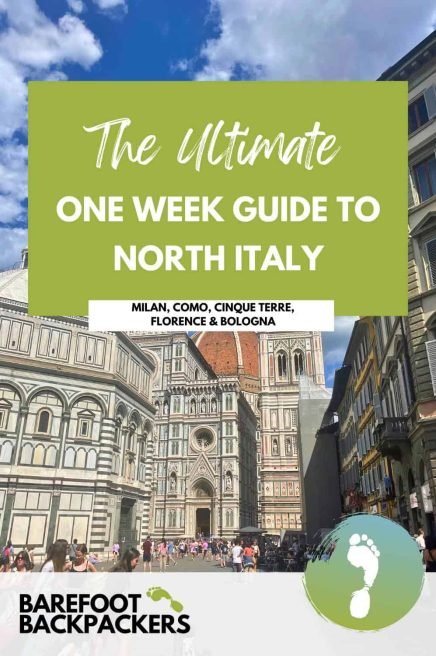This northern Italy itinerary a dream for backpackers and holidaymakers alike. We have never heard anybody say they don’t like Italy. It’s a region where history meets natural beauty, where Renaissance art sits side by side with rustic pasta, and where coastal hikes are rewarded with swims. The pace is slower, and locals live by the phrase il dolce far niente, which means ‘the sweetness of doing nothing.’ The quality of the food is second to none, the people are joyous, the language is beautiful, and the weather is reliably consistent and warm. Can you tell we love Italy yet?
Whether it’s your first trip to Italy or your tenth, this northern Italy itinerary is the perfect balance of big cities, countryside charm, and seaside escapes. We spent six nights in Northern Italy, moving through Milan, Lake Como, Cinque Terre, Florence, and Bologna. This is a fast pace, but it gave us enough time to see the highlights. If you have more time, this can easily be spaced out into a 10-day to two-week trip.
Read more: Ultimate Italy 10 Day Itinerary
This itinerary is perfect for travelers with a week in Italy or anyone looking for a shorter Italy itinerary to combine with other European destinations. Here’s how to spend six unforgettable days exploring North and central Italy.
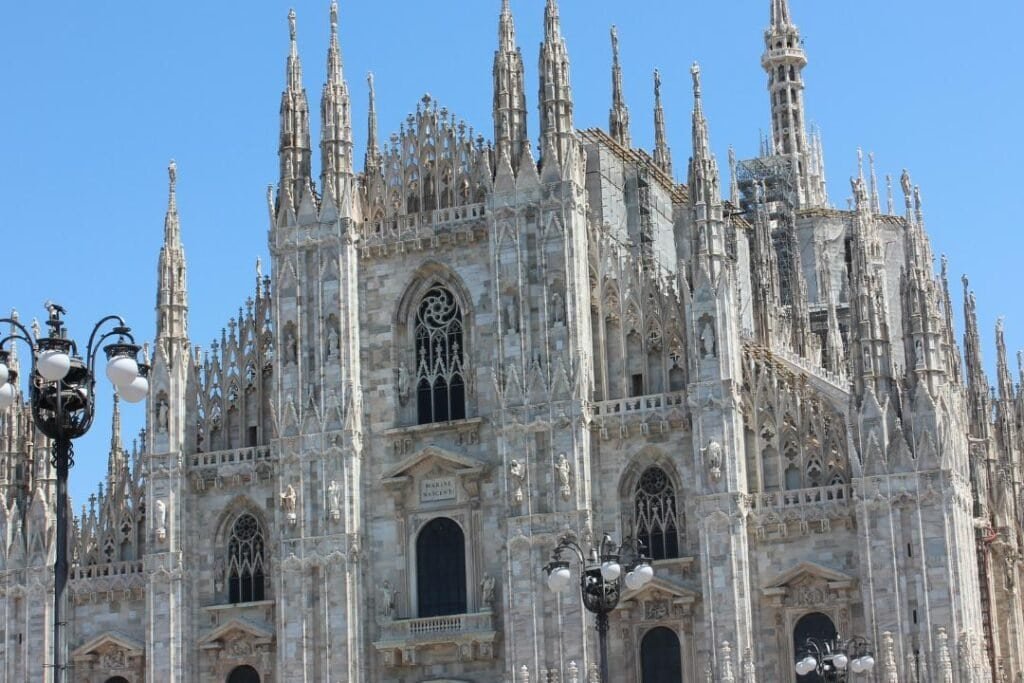
This blog is supported by the community. If you choose to purchase through our links, we may earn a small commission, which allows us to keep creating content. As an Amazon Associate, we earn from qualifying purchases. Learn more.
One week Italy Northen itinerary: Milan, Lake Como, Cinque Terre, Florence & Bologna
Day 1: Milan
We arrived in Milan, an excellent value entry point with plenty of budget flight options. Milan is often overlooked in favor of Rome or Florence, but it makes the perfect starting point for a northern Italy itinerary of 6 or 7 days. Begin your day at the Duomo di Milano, a Gothic cathedral that took nearly six centuries to complete. If you are not a fan of pigeons, this may not be your favorite spot, but climbing to the rooftop is well worth it for sweeping views across the city and the Alps on a clear day.
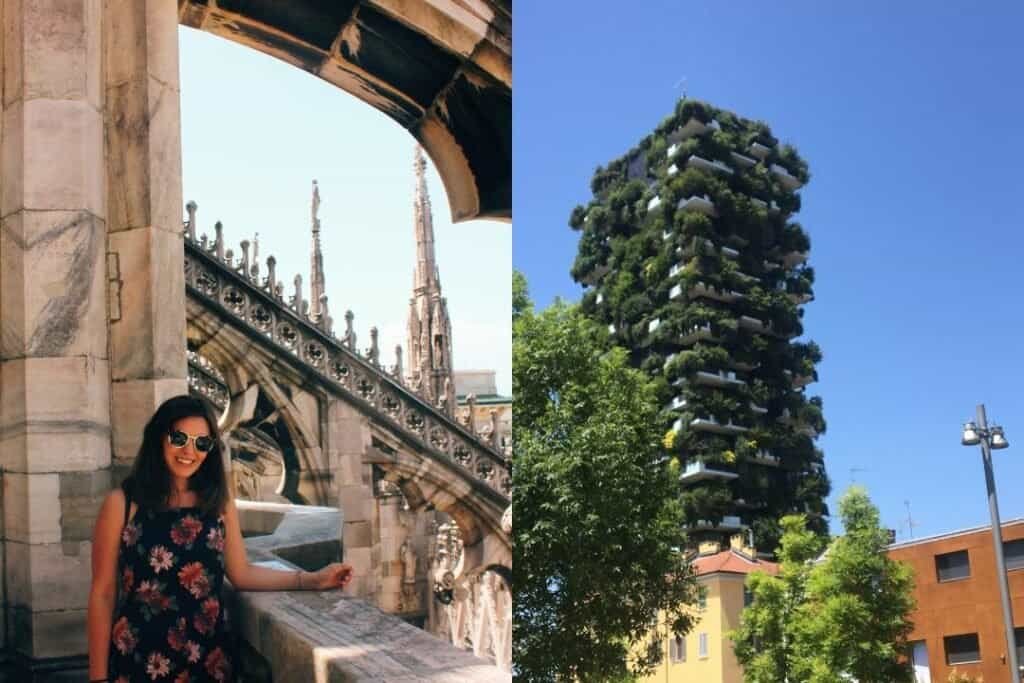
Art lovers shouldn’t miss Leonardo da Vinci’s The Last Supper, housed at the Convent of Santa Maria delle Grazie. Tickets sell out weeks in advance, so booking early is essential. After sightseeing, wander through the Galleria Vittorio Emanuele II, the world’s oldest shopping arcade, where high fashion meets grand architecture, and the atmosphere alone is a treat. We also like the Bosco Verticale, also known as the “Vertical Forest,” which is a pair of residential towers that are renowned for their extensive integration of vegetation.
For dinner, join locals for aperitivo — Milan’s version of happy hour, where drinks are served with generous small plates of food. It is excellent value and helps curb your hunger before the locals head out for late dinners around 8 or 9 pm. Try a spritz or Negroni at Camparino in Galleria before moving on to a meal. We loved the risotto alla Milanese, golden with saffron. Delicious.
Food & Drink Suggestions in Milan
- Luini – famous for panzerotti (stuffed pastries, great for a quick bite)
- Gelateria Paganelli – artisanal gelato since 1930, with seasonal flavors
Day 2: Lake Como — Villas, Views & Gelato
On your second day, take a train trip north to Lake Como. Trains depart regularly from Milano Centrale, with tickets starting from around 5–10 euros one way as of 2025, and the journey takes just over an hour. Tickets can be purchased in advance online or at the station, and regional trains are usually easy to book on the day.
Lake Como is one of the most glamorous and storied lakes in Italy, beloved since Roman times and dotted with villas that once belonged to nobility. Today, it remains a retreat for both locals and international visitors. Begin in Como town itself, strolling the lakeside promenade and the old town’s cobbled streets. A funicular takes you up to Brunate for breathtaking views across the lake.
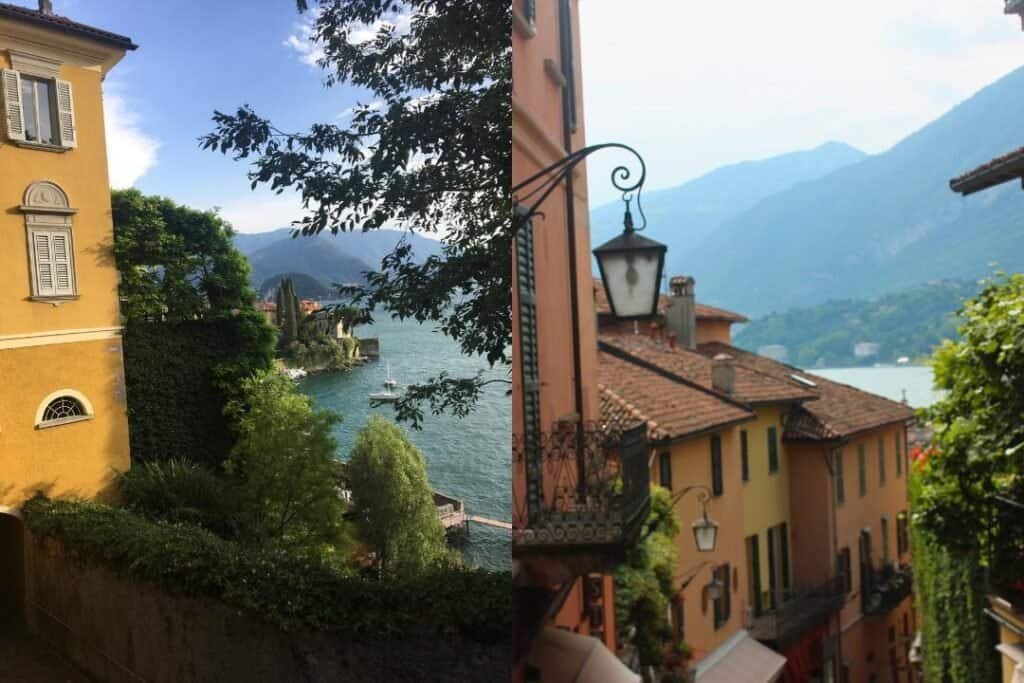
We highly recommend taking the ferries that connect the picturesque towns of Bellagio, Varenna, and Menaggio. Bellagio is known as the “Pearl of the Lake” for its stunning position and elegant villas. Varenna is quieter, with narrow alleys, a lakeside walkway, and romantic charm. If you can, take a boat tour across the lake to see the grand villas and gardens from the water — Villa Balbianello is one of the most famous.
No trip to Lake Como is complete without gelato, of course. Look for small artisanal gelaterias where the colors are natural rather than bright, the gelato selection is small, which means it’s more likely made in-house and is stored in stainless steel tubs, not plastic. That’s when you know you have hit the good spots. We loved pistachio gelato as our go-to or lemon sorbet.
Day 3–4: Cinque Terre — Colorful Villages & Coastal Trails
From Milan, take the train to Cinque Terre, a string of five villages perched on cliffs above the Ligurian Sea. Base yourself in either Monterosso, the best option for beaches, or Vernazza, the most atmospheric. Budget travelers might prefer staying in La Spezia, the main gateway to the region, which offers more affordable accommodation and easy train access to the villages. We stayed in La Spezia as it offered well-priced accommodations and was well-connected to the smaller towns and to the main cities.
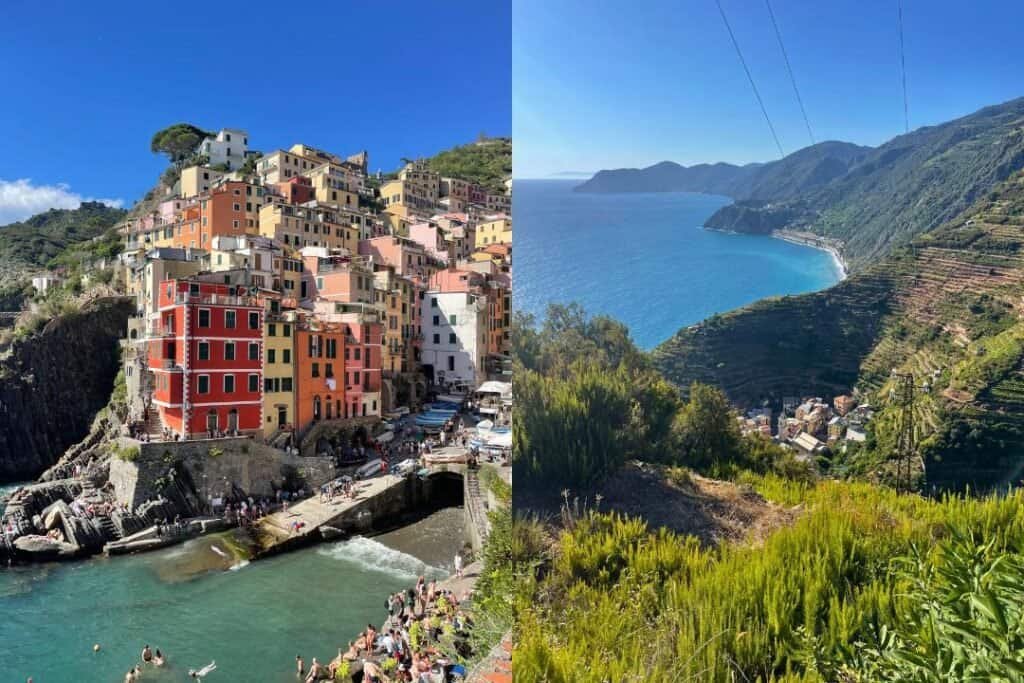
Spend your first afternoon in Monterosso al Mare, where the sandy beach is perfect for a dip in the sea. In the evening, climb Vernazza’s castle tower for panoramic views as the sun sets. Local food is a highlight here: pesto was invented in Liguria, so try trofie al pesto, along with anchovy dishes, fresh focaccia, and local white wine.
Second day in Cinque Terre
On your second day, we recommend hiking the Sentiero Azzurro, or Blue Trail, which connects the villages. The section between Vernazza and Corniglia is especially scenic, winding through terraced vineyards and olive groves with dramatic sea views. Make sure you wear practical shoes, a hat, and some breathable clothing as you will work up a sweat. For those who prefer to skip the hike, regional trains run frequently between the villages and are quick and affordable.
Manarola is especially beautiful at golden hour, when the pastel houses glow in the evening light. It is one of the most photographed spots in Italy, and it’s easy to see why. Cinque Terre may be busy in high season, but even with the crowds, its charm is undeniable. One of our favourite places in Italy.
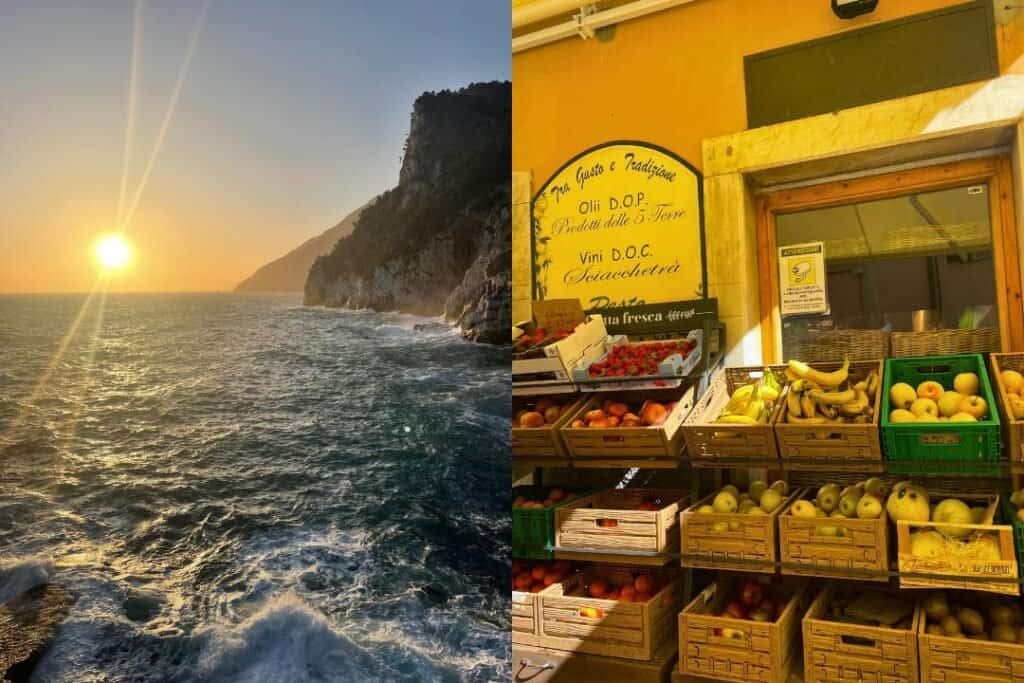
A special more unknown spot for sunset is Portovenere, a from the rocky terraces of a cave formerly known as Grotta Arpaia. Portovenere is a secret spot often associated with the Romantic poet Lord Byron, who famously swam there. The site offers stunning coastal views and a dramatic rocky landscape that can be easily accessed by bus from La Spezia.
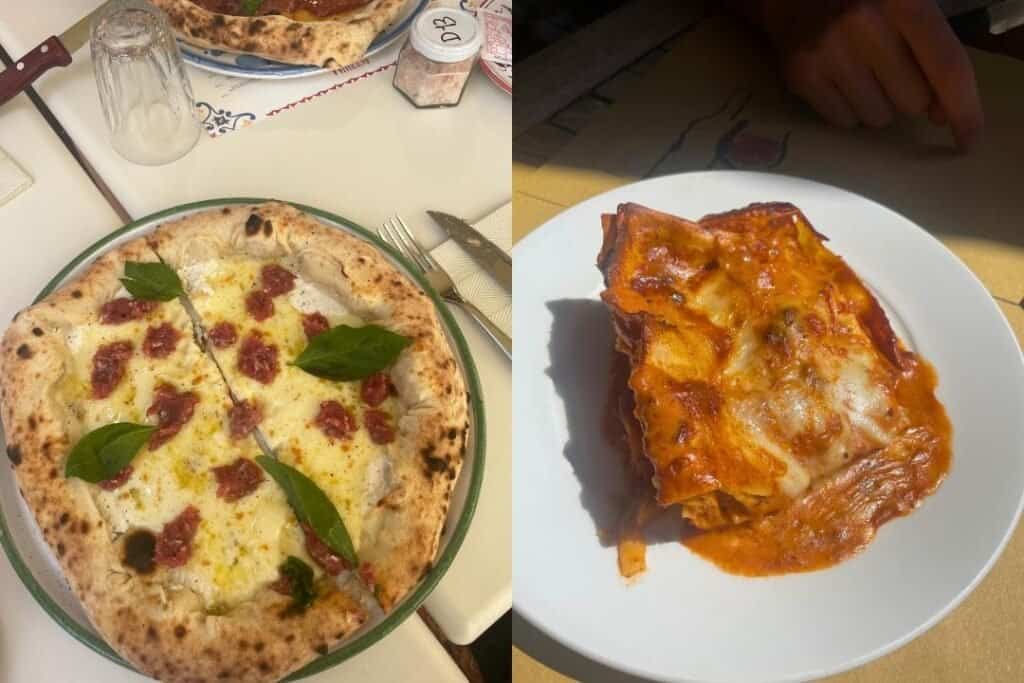
Food & Drink Suggestions in Cinque Terre
- Pizzium (La Spezia) – Hands down the best pizza we had this trip. Pictured above.
- Pasticceria Laura (Monterosso) – a small bakery with Ligurian sweets and focaccia
- Gelateria Vernazza – known for basil-flavored gelato
Day 5: Florence — Renaissance Architecture & Tuscan Charm
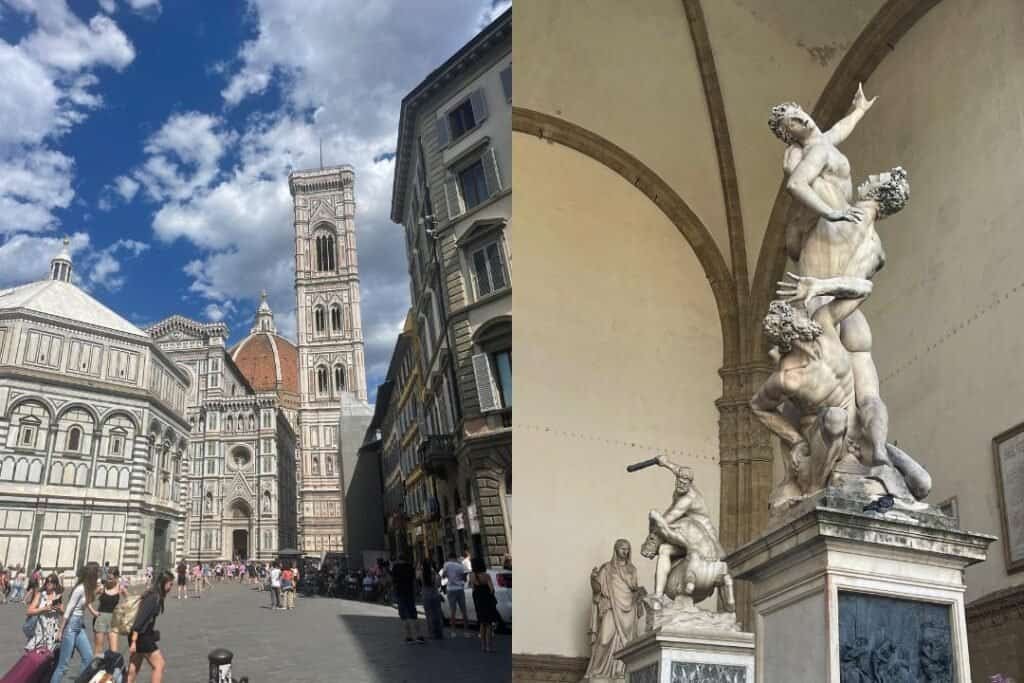
Next stop: Florence, the jewel of Tuscany and a city that deserves to be explored at a slower pace. Start at the Duomo, climbing Brunelleschi’s dome for views across terracotta rooftops. The Uffizi Gallery is a must for art lovers, with Botticelli’s Birth of Venus and masterpieces by Michelangelo, Leonardo, and Caravaggio. At sunset, the most famous and highly recommended spot in Florence is Piazzale Michelangelo. It is extremely busy but offers panoramic views of the city’s skyline, including the Duomo and Ponte Vecchio, as the sun sets.
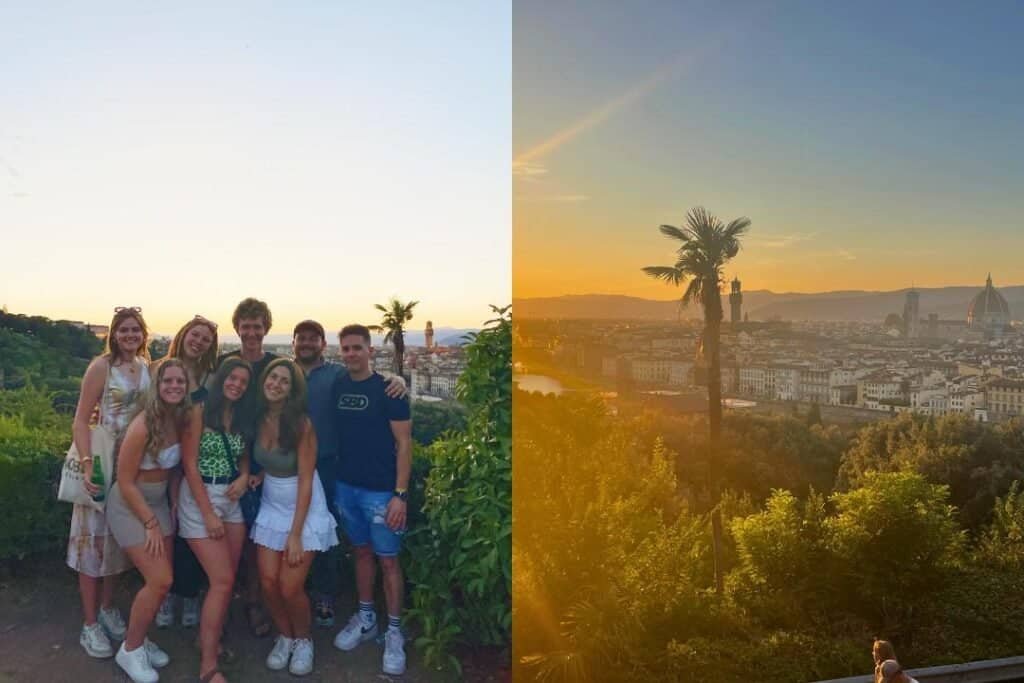
On your second day, stroll across the Ponte Vecchio, Florence’s iconic medieval bridge lined with jewelers, and wander into the Boboli Gardens for a break from the city. Food here is as important as the art — bistecca alla Fiorentina is the classic dish, though street food like lampredotto sandwiches offer a more authentic taste of the city. Pair your meals with a glass of Chianti, one of Tuscany’s famous wines.
Florence also makes a wonderful base for day trips to Pisa, Siena, or the Tuscan countryside, too. We took a day trip to Bologna, which was very straightforward.
We stayed at YellowSquare Hostel Florence, which was a little further out from the center but had a rooftop pool, modern rooms, and plenty of events to meet other travelers. It was the perfect social base for backpackers if that is something you are looking for.
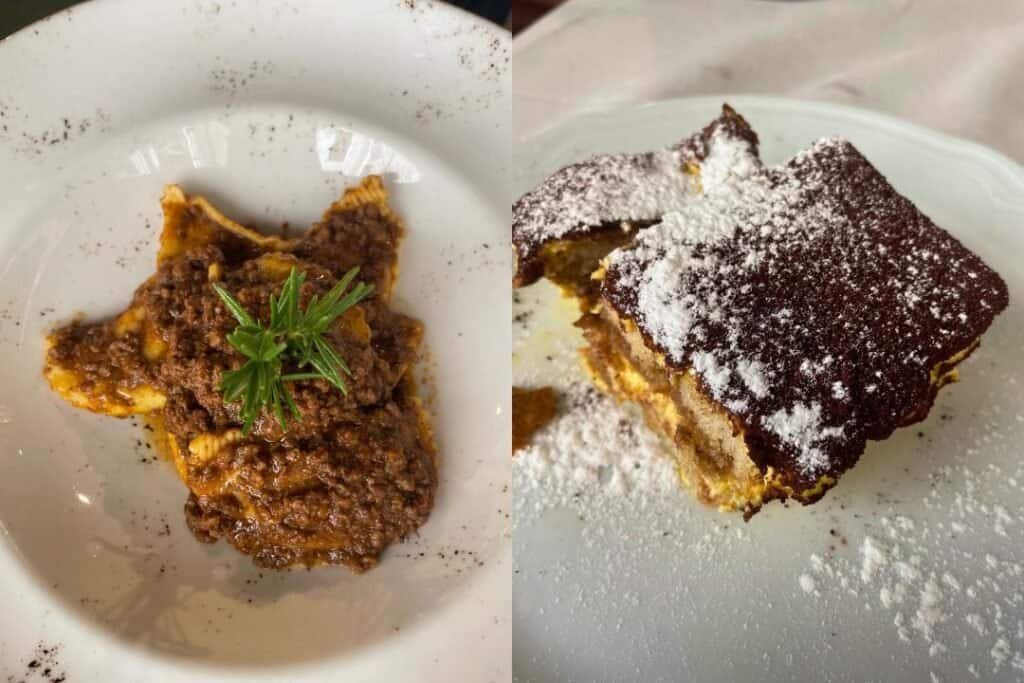
Food & Drink Suggestions in Florence
- Mercato Centrale – indoor food market with fresh Tuscan produce and street food
- Trattoria Mario – iconic Florentine spot for bistecca alla Fiorentina
- All’Antico Vinaio – legendary sandwiches with fresh, local ingredients
- Gelateria La Carraia – a favorite gelato stop for both locals and travelers
- La Bussola – Delicious tiramsu
Day 6: Bologna
Bologna, just an hour by train from Florence, is one of Italy’s most underrated cities and a true paradise for food lovers. We arrived by bus and were welcomed into a city that feels less polished than Florence but every bit as rich in history and culture.
Begin at Piazza Maggiore, the city’s central square, before climbing the Asinelli Tower for views over Bologna’s red rooftops. But the real joy of Bologna lies in its food. This is the birthplace of tagliatelle al ragù, tortellini in broth, mortadella, and lasagne.
We had recommendations from a friend who trained as a chef in Bologna, so we were in for a treat! We ate a lot of pastries, pasta, cheeses, and gelato that exceeded every expectation.
Bologna’s Food Scene
On arrival, we had a late breakfast at Café Gamberini. We started with cannoli and croissants, both bursting with pistachio cream and ricotta. Paired perfectly with a cappuccino and a freshly squeezed orange juice. All that came to just 12.40 euros.
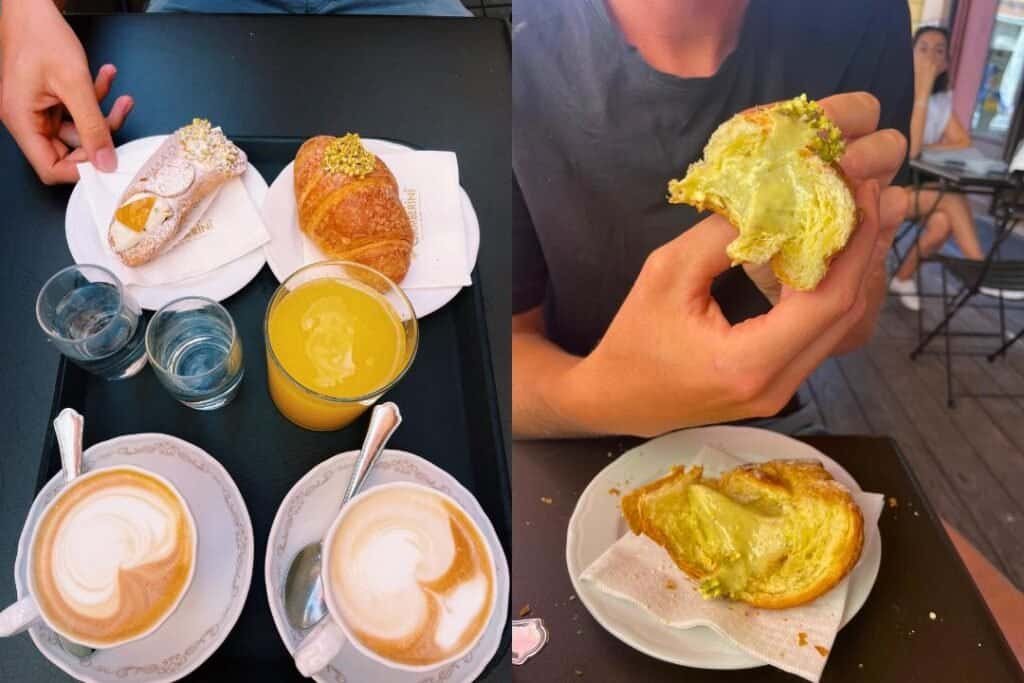
Then we walked up to the Sanctuary of Madonna di San Luca, climbing the arched porticoes to reach the hilltop church. The walk upwards felt like a powerful meditation. We reflected on our travels, our intentions, and were treated to beautiful views of Tuscany from the top.
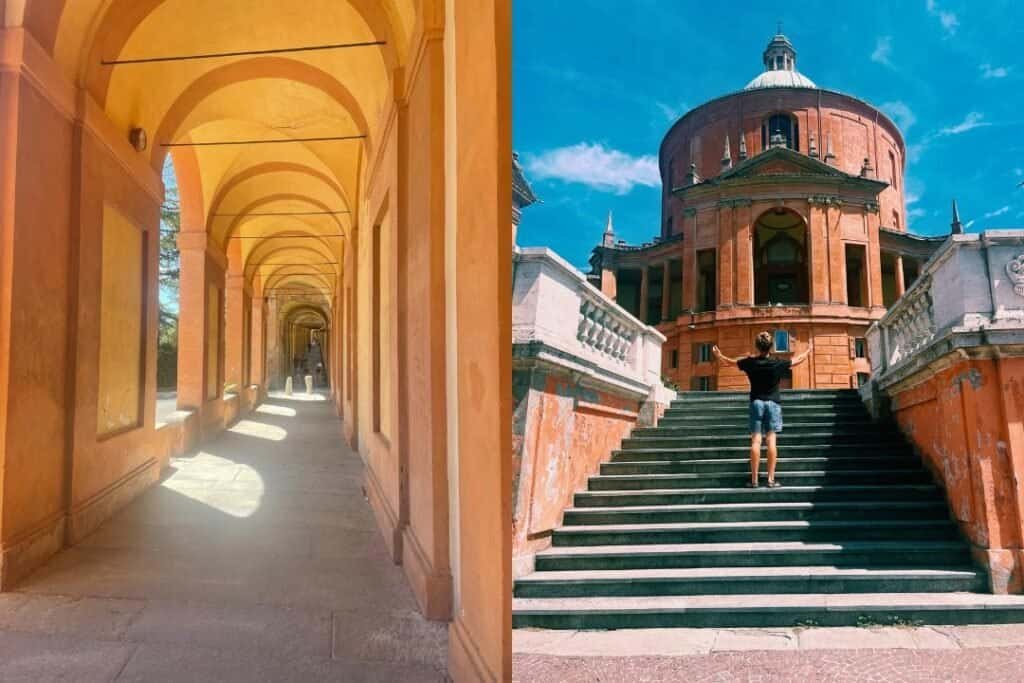
Our early dinner was at Sfoglia Rina. A cozy pasta restaurant where we ordered our friend’s suggestions: a plate of local cheeses, cold cuts, and warm tigelle (fresh flatbreads). The tagliatelle ragu (or, as many know it, bolognese) and tortellini with butter and sage stuffed with ricotta were divine, all washed down with organic wine. We cannot recommend this place enough, extremely good quality, vibes, and the food was spectacular.
Our sweet finale was at Cremeria Santo Stefano. Hands down, the best gelato we had. It was top quality, and you could taste the difference.
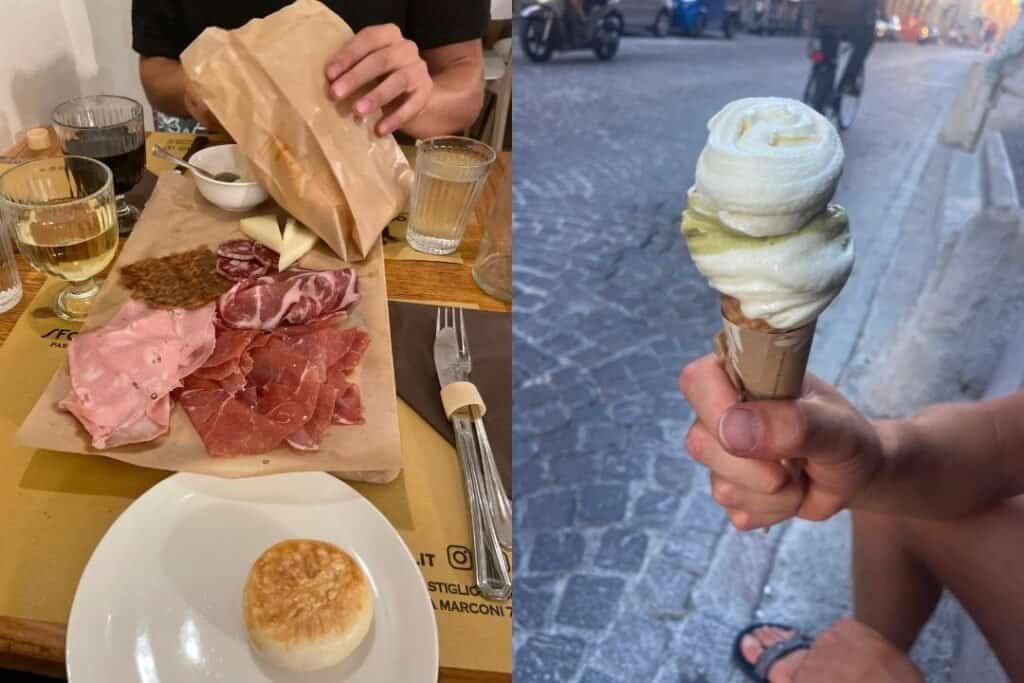
Food & Drink Suggestions in Bologna
- Caffè Pasticceria Gamberini – historic bakery for cannoli, croissants, and cappuccinos
- Sfoglia Rina – cozy restaurant with some of the city’s best handmade pasta
- Cremeria Santo Stefano – artisanal gelato with natural ingredients
- Pizzeria Altero – classic Bolognese pizza by the slice for takeout
Day 7: Travel Day
We flew out from Florence, but depending on your plans, you can easily return to Milan or continue south toward Rome. Trains are reliable, fast, and affordable, making Northern Italy one of the easiest regions in Europe to travel.
Tips for a Northern Italy Itinerary
Best time to visit: Spring (April–June) and autumn (September–October) for pleasant weather and fewer crowds.
Getting around: Trains are the easiest and most efficient way to travel. High-speed lines connect Milan, Florence, and Bologna, while regional trains serve Cinque Terre.
Budget tip: Aperitivo in Milan or Florence can be a full dinner alternative — generous snacks are often included with drinks.
Packing: Bring comfortable walking shoes, a scarf for church visits, and layers for evenings by the coast.
FAQ: Planning a Northern Italy Itinerary
What is a good itinerary for Italy in seven days?
A northern Italy itinerary like Milan, Lake Como, Cinque Terre, Florence, and Bologna for a week is quick but you can see a lot due to the cities being well connected and fairly close by.
How to plan an Northen Italy itinerary?
Start with how many days you have, then choose two to four key stops. Use trains for easy connections or Flixbus.
How many days do you need in Northern Italy?
With 6–7 days, you can comfortably visit three or four cities. For a slower pace, choose two bases such as Florence and Cinque Terre, and take day trips from there.
What is the best itinerary for Italy?
The best itinerary depends on your interests, but many travelers love combining culture-rich cities like Florence with relaxing spots like Cinque Terre, Lake Como, or Tuscany.
Enjoyed our One Week in North Italy Itinerary? Read more
The Barefoot Backpackers’ India Travel Guide
The Ultimate One Week in Greece Itinerary
One Week in Morocco Itinerary: Chefchaouen, Fes & Marrakech








